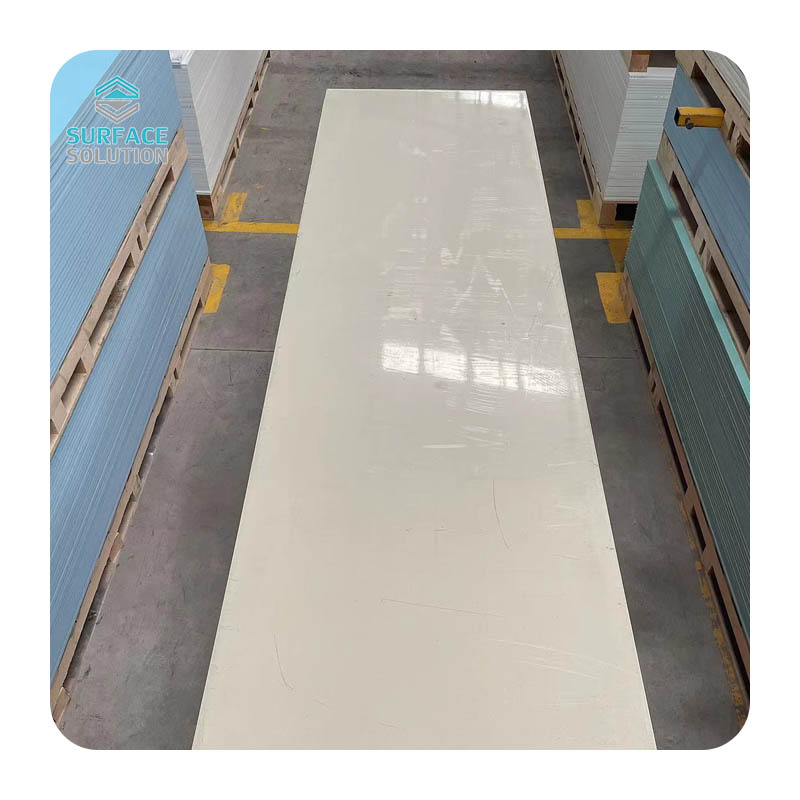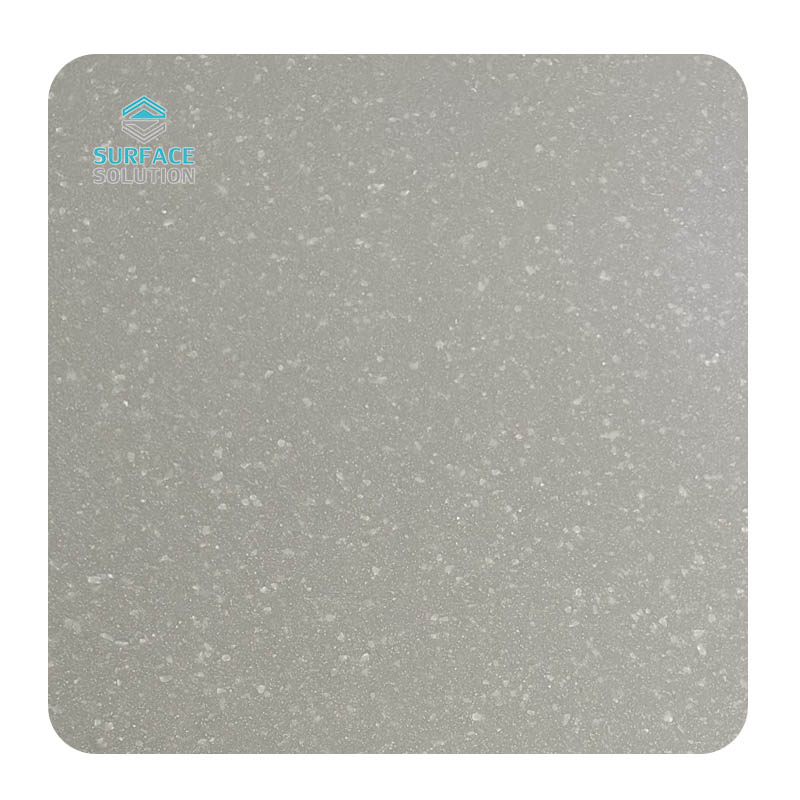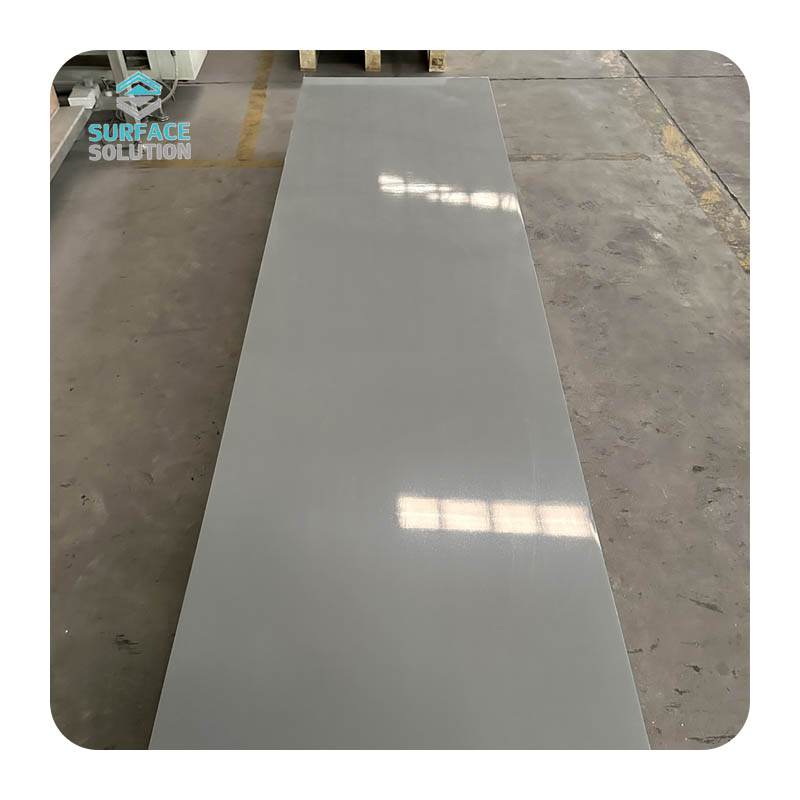Space-Saving Solutions with Acrylic Solid Surface Designs
In an era of shrinking living and working spaces—from micro-apartments in urban centers to compact café kitchens—designers and homeowners are increasingly prioritizing "space efficiency" without sacrificing style or functionality. Enter acrylic solid surfaces: a man-made material celebrated for its seamless adaptability, moldable structure, and low-maintenance appeal. Unlike rigid natural stones (e.g., granite) or fragile laminates, acrylic solid surfaces can be custom-shaped, joined without visible seams, and integrated into multi-purpose setups—making them a game-changer for maximizing tight spaces. Below, we break down key space-saving design strategies leveraging acrylic solid surfaces, with real-world applications and material benefits. 1. Seamless Integrated Furniture: Eliminate "Wasted" Gaps
One of the biggest space hogs in small rooms is the gaps between separate furniture pieces—think the crack between a countertop and a backsplash, or the space under a standalone desk. Acrylic solid surfaces solve this with seamless fabrication: when heated and molded, acrylic can be crafted into single, continuous pieces that fit perfectly into awkward corners or custom dimensions, leaving no gaps for dust, clutter, or unused space.

Example 1: Kitchen "Wall-to-Wall" Compact Counters
In a tiny kitchen, every inch counts. Acrylic solid surface countertops can be custom-cut to span from one wall to the other, with no visible seams between the countertop and backsplash (or even the sides of cabinetry). Unlike tile backsplashes (which require grout lines that trap debris), the seamless acrylic surface creates a smooth, unbroken plane—reducing the need for extra storage (e.g., no separate backsplash cleaner) and visually expanding the space. For added efficiency, designers often integrate shallow acrylic shelves directly into the backsplash (molded as one piece) to hold spices or utensils, eliminating the need for bulky wall racks. Example 2: Bathroom Floating Vanities with Built-In Storage
Traditional bathroom vanities with legs take up floor space and collect dust underneath. Acrylic solid surface floating vanities, by contrast, are mounted to the wall (freeing up floor space for a small stool or storage basket) and can be fabricated with hidden internal drawers (molded into the acrylic structure). The seamless design means no gaps between the vanity top and drawers—preventing clutter buildup—and the material’s water-resistant properties make it ideal for bathroom humidity (no warping or staining, unlike wood).
2. Multi-Purpose Acrylic Fixtures: One Piece, Multiple Uses
In small spaces, furniture that serves only one function (e.g., a single-use coffee table) is a luxury. Acrylic solid surfaces shine here: their durability (resistant to scratches, heat, and mild chemicals) and moldability allow them to be shaped into multi-purpose fixtures that adapt to changing needs.
Example 1: Convertible Acrylic Dining/Work Tables
For studio apartments, an acrylic solid surface table can be designed with a foldable or (liftable) top: by day, it acts as a compact desk (low height, narrow width); by night, it lifts to dining-table height and expands slightly (via hidden hinges) to seat 2–3 people. The acrylic’s lightweight yet sturdy nature makes adjusting the table easy, while its smooth surface works equally well for laptops and dinner plates. Unlike glass tables (which are heavy and prone to chipping), acrylic is shatter-resistant—critical for multi-use spaces where accidents happen.
Example 2: Acrylic "Dual-Role" Bathroom Counters
In a small bathroom, an acrylic solid surface counter can double as a vanity top and a linen shelf. The counter is fabricated with a slight overhang on one side, and a thin acrylic lip (molded into the counter) creates a shallow shelf underneath—perfect for stacking towels or toilet paper. The seamless design means no separate shelf brackets (which take up wall space) and the material’s non-porous surface ensures towels stay clean (no moisture seeps into the material).

3. Vertical Space Utilization: Go "Up" Instead of "Out"
Small spaces often have underused vertical space—walls, corners, and even ceiling areas. Acrylic solid surfaces, being lightweight and easy to mount, excel at turning vertical areas into functional zones without making the room feel cramped (thanks to their translucent or matte finishes that reflect light, rather than blocking it).
Example 1: Acrylic Wall-Mounted Desks and Workstations
For home offices in closets or nooks, an acrylic solid surface wall-mounted desk can be folded up when not in use—lying flat against the wall like a panel. When needed, it folds down to a 24-inch deep work surface, with optional acrylic side brackets (molded into the desk) to hold a laptop or notebook. The material’s slim profile (as thin as ½ inch) means it doesn’t protrude awkwardly from the wall, and its heat resistance allows for laptop use without a coaster.
Example 2: Corner Acrylic Shelving Units
Empty corners are often overlooked, but acrylic solid surface corner shelves turn them into storage gold. These shelves are custom-molded to fit 90-degree corners, with no visible supports (the acrylic is mounted directly to the wall via hidden hardware). Unlike wooden corner shelves (which can look bulky), acrylic’s transparency or soft matte finish keeps the space feeling open—perfect for displaying books, plants, or toiletries without overwhelming the room. The non-porous surface also makes cleaning easy (a quick wipe with a damp cloth removes dust or spills).
4. Visual Space Expansion: Acrylic’s "Lightweight" Aesthetic
Even the most functional space-saving design fails if it makes a room feel claustrophobic. Acrylic solid surfaces address this with their visual lightness: unlike dark granite or heavy wood, acrylic reflects natural and artificial light, creating the illusion of more space. It also comes in a range of light hues (white, soft gray, pale beige) that blend with wall colors, further expanding the room visually.
Example: Acrylic Kitchen Island with Open Base
A small kitchen might seem too tight for an island—but an acrylic solid surface island changes that. The island’s top is a thin, seamless acrylic slab, and the base is made of acrylic legs (slim, cylindrical, or rectangular) instead of closed cabinetry. The open base keeps the floor visible (no blocked sightlines) and allows light to pass through, making the kitchen feel larger. The island can still include hidden storage (e.g., a small acrylic drawer under the top) for utensils, keeping clutter out of sight.
Why Acrylic Solid Surfaces Outperform Other Materials for Space-Saving
What makes acrylic stand out from alternatives like laminate, stone, or wood?
Durability: Resistant to scratches, stains, and water, acrylic fixtures last longer—no need to replace worn items that take up space.
Final Thoughts: Acrylic as a "Space-Saving Partner"
Space-saving design isn’t just about squeezing more furniture into a room—it’s about creating spaces that feel open, functional, and enjoyable to use. Acrylic solid surfaces excel at this by merging adaptability with aesthetics: they can be custom-tailored to fit tight corners, serve multiple roles, and visually expand small areas—all while requiring minimal maintenance. Whether you’re designing a micro-apartment, a compact café, or a busy home office, acrylic solid surface designs prove that "small space" doesn’t have to mean "limited style."
In the end, the best space-saving solutions are those that work with the material—and acrylic solid surfaces are built to work with even the most challenging spaces.




 Space-Saving Solutions with Acrylic Solid Surface DesignsIn an era of shrinking living and working spaces—from micro-apartments in urban centers to compact café kitchens—designers and homeowners are increasingly prioritizing "space efficiency" without sacrificing style or functionality. Enter acryli
Space-Saving Solutions with Acrylic Solid Surface DesignsIn an era of shrinking living and working spaces—from micro-apartments in urban centers to compact café kitchens—designers and homeowners are increasingly prioritizing "space efficiency" without sacrificing style or functionality. Enter acryli How to Find the Surface Area of a Solid: A Step-by-Step GuideThe surface area (SA) of a solid is the total area of all its outer faces or surfaces. Unlike volume (which measures space inside a solid), surface area focuses on the "outside"—a key measurement for real-world tasks like wrapping a gift (
How to Find the Surface Area of a Solid: A Step-by-Step GuideThe surface area (SA) of a solid is the total area of all its outer faces or surfaces. Unlike volume (which measures space inside a solid), surface area focuses on the "outside"—a key measurement for real-world tasks like wrapping a gift ( What Are Solid Surface Countertops Made Of? A Deep Dive Into Their CompositionSolid surface countertops have become a staple in modern kitchens and bathrooms, celebrated for their seamless appearance, durability, and versatility. Unlike natural stone (such as granite or marble) or laminate, they are
What Are Solid Surface Countertops Made Of? A Deep Dive Into Their CompositionSolid surface countertops have become a staple in modern kitchens and bathrooms, celebrated for their seamless appearance, durability, and versatility. Unlike natural stone (such as granite or marble) or laminate, they are What Are Solid Surface Countertops? A Complete OverviewIn kitchen and bathroom design, solid surface countertops stand out as a versatile choice, balancing functionality, aesthetics, and durability. Unlike natural stone (granite, marble) or synthetic quartz, they offer unique benefits—but what exact
What Are Solid Surface Countertops? A Complete OverviewIn kitchen and bathroom design, solid surface countertops stand out as a versatile choice, balancing functionality, aesthetics, and durability. Unlike natural stone (granite, marble) or synthetic quartz, they offer unique benefits—but what exact















